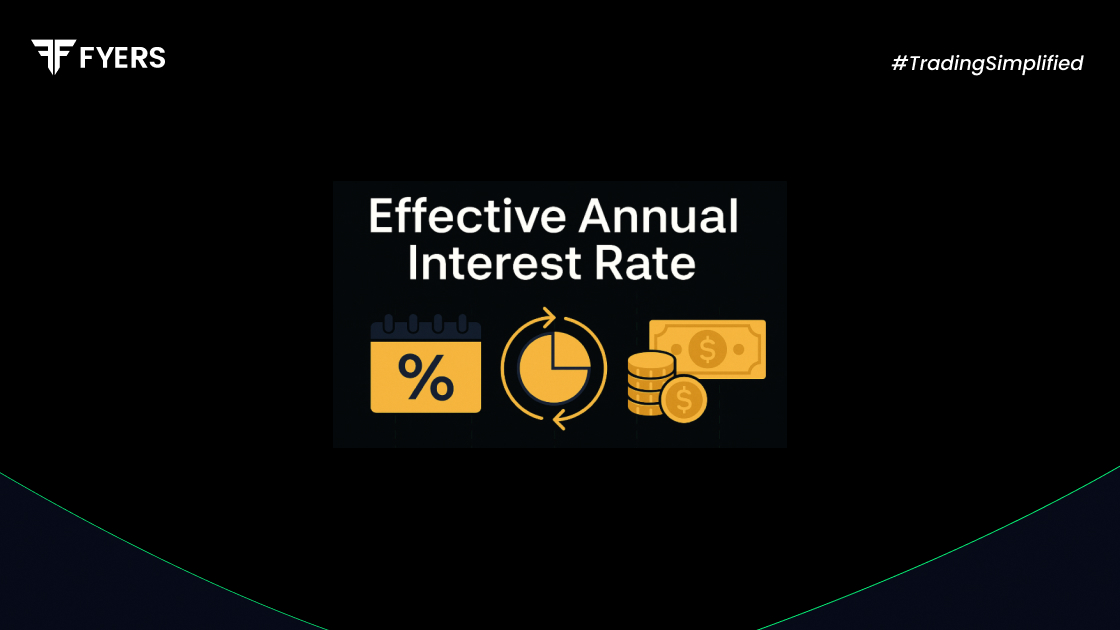

 26 Sep, 2025
26 Sep, 2025
 4 mins read
4 mins read

In finance, numbers can be deceiving. A loan or investment may appear attractive at first glance, but without understanding the effective annual interest rate, the real cost or return often remains hidden. This measure cuts through the surface figures, revealing what you truly pay or earn once compounding is considered. For anyone comparing credit cards, bank deposits, or business loans, knowing how this works is like seeing the fine print in bold.
The effective annual interest rate (EAR), also called the annual equivalent rate (AER), represents the real return on an investment or the actual cost of a loan over one year, taking compounding into account.
Unlike the nominal rate, which ignores compounding periods, the EAR reflects the effect of multiple compounding cycles within the year. This makes it a more reliable indicator of the true rate you earn or pay.
For example, a 10% nominal rate compounded monthly will result in a higher effective rate because of the compounding effect.
The concept of EAR is based on compounding. Compounding occurs when interest is added to the principal, and future interest is calculated on the new total. The more frequently this happens, the higher the overall rate becomes.
For instance, imagine a savings account with quarterly compounding. Although the bank advertises a nominal annual rate, the quarterly additions mean you end up earning more than the stated figure by year-end.
On the borrowing side, a monthly compounding loan results in higher interest paid compared to an annual compounding loan, even at the same nominal rate.
The EAR matters because it brings clarity and fairness to financial decisions.
True cost of borrowing: It reveals the real interest borrowers pay in a year, making comparisons between loans easier.
Accurate investment comparisons: Investors can identify which option provides the best return once compounding is considered.
Transparency: It reduces the chances of being misled by nominal figures.
Better decision-making: EAR ensures more informed choices when weighing financial products.
The formula to calculate the effective annual interest rate is:
|
EAR = (1 + i/n)ⁿ – 1 |
Where:
i = nominal annual interest rate
n = number of compounding periods per year
For instance:
Annual compounding → n = 1
Semi-annual compounding → n = 2
Quarterly compounding → n = 4
Monthly compounding → n = 12
Understanding how to calculate the effective interest rate helps ensure accurate comparisons between products.
While EAR is powerful, it is not without limits:
Excludes fees and taxes: It focuses only on compounding and does not include service charges, taxes, or processing fees.
Assumes reinvestment: It presumes that all interest earned is reinvested at the same rate, which is not always possible.
Less useful for variable rates: In products where rates change, EAR is less meaningful.
Ignores timing of cash flows: The exact timing of payments or receipts is not captured.
Despite these, the EAR remains one of the most dependable tools for comparing financial products.
The effective annual interest rate goes beyond surface-level numbers and reveals the reality of borrowing and investing. By factoring in compounding, it shows what you truly gain or owe in a year. From business loans to personal investments, using EAR can prevent costly mistakes and guide smarter financial decisions. In a world where money grows or drains faster than it seems, EAR ensures you are looking at the real picture.
The nominal rate is the stated annual interest without considering compounding. The effective rate accounts for compounding and shows the actual yearly return or cost. When compounding occurs more than once a year, the effective rate is higher than the nominal rate.
The effect becomes stronger as compounding frequency increases. Daily or monthly compounding results in a higher EAR compared to semi-annual or annual compounding, especially when interest rates are higher.
No, the effective annual rate only reflects compounding effects. Fees, service charges, and taxes must be considered separately to get the complete picture.
Calculate your Net P&L after deducting all the charges like Tax, Brokerage, etc.
Find your required margin.
Calculate the average price you paid for a stock and determine your total cost.
Estimate your investment growth. Calculate potential returns on one-time investments.
Forecast your investment returns. Understand potential growth with regular contributions.